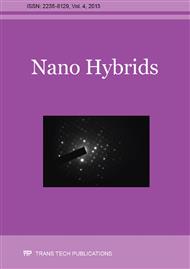[1]
Y. Kumara, M. Herrera, F. Singh, S.F. Olive-Méndez, D. Kanjilal, S. Kumar, Cathodoluminescence and photoluminescence of swift ion irradiation modified zinc oxide-porous silicon nanocomposite, Mater. Sci. Eng. B 177 (2012) 1476-1481.
DOI: 10.1016/j.mseb.2012.01.017
Google Scholar
[2]
W.S. Sarle, Neural Networks and Statistical Models, Proceedings of the Nineteenth Annual SAS Users Group International Conference, Cary, NC (1994).
Google Scholar
[3]
S. Brosse, J.F. Guegan, J.N. Tourenq, S. Lek, The use of artificial neural networks to assess fish abundance and spatial occupancy in the littoral zone of a mesotrophic lake, Ecol. Model. 120 (1999) 299-311.
DOI: 10.1016/s0304-3800(99)00110-6
Google Scholar
[4]
A. Iglesias, B.A. Varela, J.M. Cotos, J.A. Taboada, C. Dafonte, A comparison between functional networks and artificial neural networks for the prediction of fishing catches, Neural Computing and Applications 13 (2004) 24-31.
DOI: 10.1007/s00521-004-0402-7
Google Scholar
[5]
D. Srinivasan, W.S. Ng, A.C. Liew, Neural-Network-Based Signature Recognition for Harmonic Source Identification, IEEE Trans. Power Delivery 21(1) (2006) 398-405.
DOI: 10.1109/tpwrd.2005.852370
Google Scholar
[6]
H.C. Lin, Intelligent Neural Network based Fast Power System Harmonic Detection, IEEE Trans. Ind. Electron. 54(1) (2007) 43-52.
DOI: 10.1109/tie.2006.888685
Google Scholar
[7]
D. Qiu, D.-J. Zhang, W. You, N.-N. Zhang, H. Li, An application of prediction model in blast furnace hot metal silicon content based on neural network, IEEE (2009) 61-64. (ODI:
DOI: 10.1109/icacia.2009.5361151
Google Scholar
[8]
D.S. Lee, S.W. Ban, B. Sang-Woo, M. Lee, D.-D. Dong, Micro gas sensor array with neural network for recognizing combustible leakage gases, IEEE Sens. J. 5 (2005) 530-536.
DOI: 10.1109/jsen.2005.845186
Google Scholar
[9]
M. Jaouadi, W. Dimassi, M. Gaidi, R. Chtourou, H. Ezzaouia, Nanoporous silicon membrane for fuel cells realized by electrochemical etching, Appl. Surf. Sci. 258 (2012) 5654-5658.
DOI: 10.1016/j.apsusc.2012.02.050
Google Scholar
[10]
N. Naderi, M.R. Hashim, A combination of electroless and electrochemical etching methods for enhancing the uniformity of porous silicon substrate for light detection application, Appl. Surf. Sci. 258 (2012) 6436-6440.
DOI: 10.1016/j.apsusc.2012.03.056
Google Scholar
[11]
K.A. Salman, K. Omar, Z. Hassan, The effect of etching time of porous silicon on solar cell performance, Superlattices Microstruct. 50 (2011) 647-658.
DOI: 10.1016/j.spmi.2011.09.006
Google Scholar
[12]
P.H. Wu, I-K. Lin, H-Y. Yan, K-S. Ou, K-S. Chen, X. Zhang, Mechanical property characterization of sputtered and plasma enhanced chemical deposition (PECVD) silicon nitride films after rapid thermal annealing, Sens. Actuators, A 168 (2011) 117-126.
DOI: 10.1016/j.sna.2011.03.043
Google Scholar
[13]
S.M. Sze, K.K. Ng, Physics of Semiconductor Device, Wiley-Interscience, New York (2007).
Google Scholar


